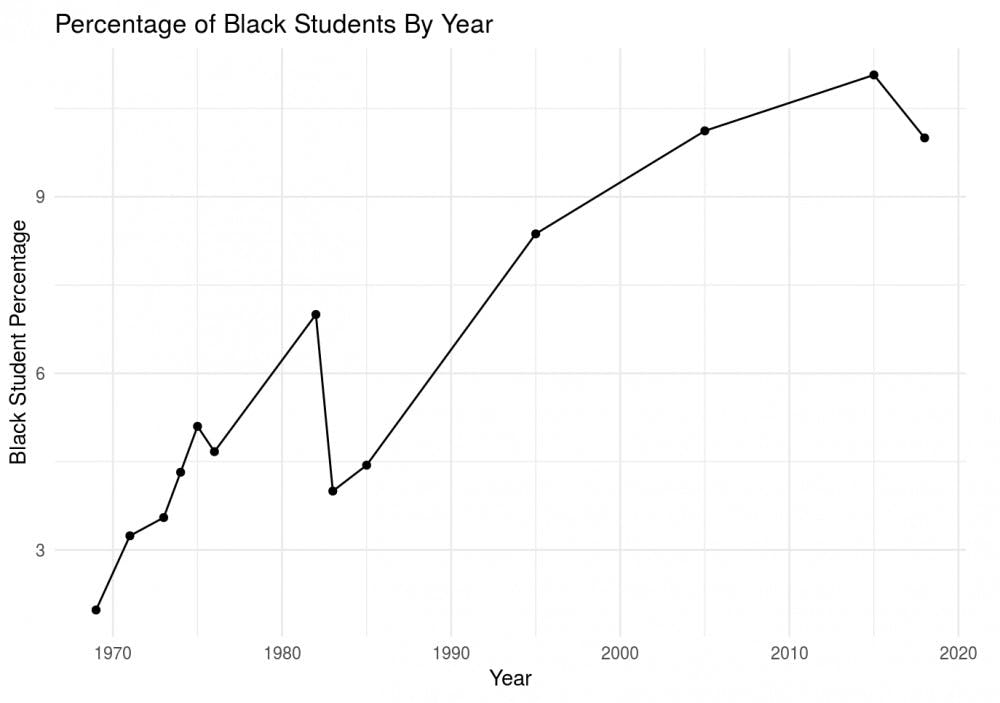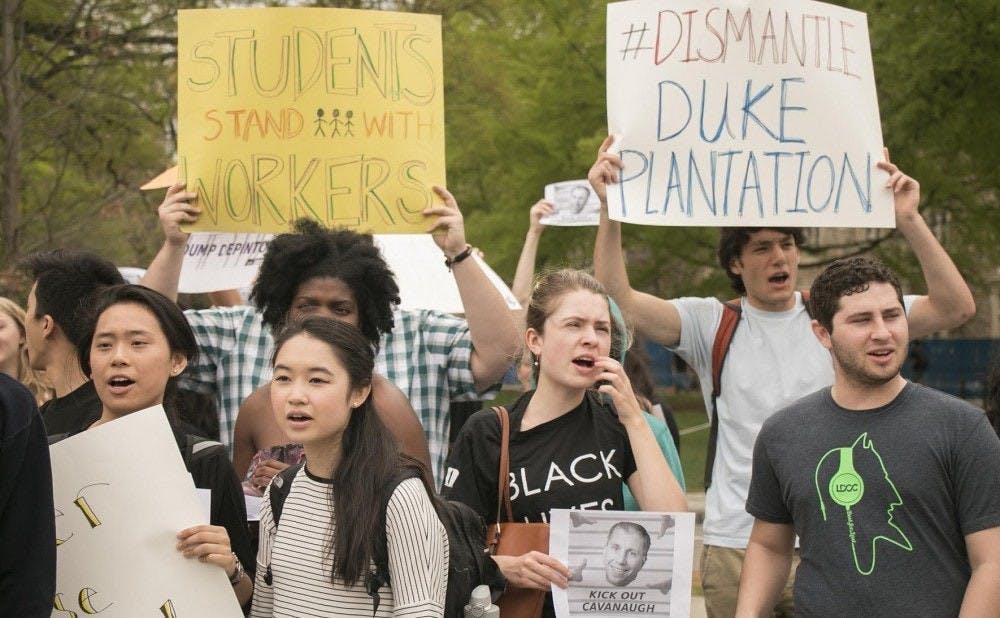The Allen Building Takeover marked a pivotal point in Duke's history of student protests.
In 1975, the Association of African Students presented a similar list of demands as in 1969, but the tone of the demonstration was notably different.
The Chronicle reported that the group quietly gathered outside the Allen Building, and the president of the association, Clemon Richardson, handed out copies of the demands to students.
The demands included departmentalizing the Black Studies Program and increasing the number of black faculty. Once the demands were read aloud, the students entered the Allen Building and walked up to the second floor, where they presented their list of grievances to several administrators.
“A line of more than 100 students formed behind Richardson, watched quietly and then silently walked out again,” The Chronicle reported.
In 1979, the Black Student Alliance held a march and rally during Black Solidarity Week to “awaken the University community to black-related problems and needs,” according to The Chronicle.
Approximately 250 African-American and white students marched from East to West Campus, singing songs such as “We Shall Overcome” and “Lift Every Voice and Sing.”
The president of BSA gave an opening speech to a crowd of around 300 people, which was followed by speeches from faculty and students about the issues and hopes they had for the future of Duke.
In May 1985, 60 graduating seniors organized a silent vigil outside the Duke Chapel during baccalaureate ceremonies to encourage Duke to divest from South Africa due to apartheid.
“We think the University has to accept the role of moral steward,” graduating senior Steve Rottman told The Chronicle at the rally.
One year later, the Board of Trustees set a deadline to withdraw all investments from South Africa if apartheid practices continued.
In 1989, another march was held on National Black Student Action day, this time with students marching from East to West Campus. The march ended in front of the Allen Building, where BSA President and then-junior Craig McKinney presented a list of goals to Provost Phillip Griffiths.
“The march, one of 40 to 80 taking place at colleges around the country, was an attempt to accelerate and intensify University action on a list of nine concerns compiled by the Black Student Association,” The Chronicle reported.
Their concerns echoed those of previous years, such as increased African-American student recruitment, expansion of the African-American Studies program and a Division of Minority Affairs.

In April 1997, campus police handcuffed and frisked first-year Calvin Harding, mistakenly thinking he was the thief of a recently stolen laptop.
In the following semester, students boycotted class as a part of a “speak-out devoted to confronting strained campus race relations,” The Chronicle reported. Students set up a podium on the chapel steps for an “open-microphone” forum about race on campus. Two hours into what was deemed “Race Day,” a long line of students continued to form, waiting for their turn to speak to a crowd whose maximum size reached 500 people.
In February 2016, The Chronicle reported that Executive Vice President Tallman Trask allegedly used a racial slur after hitting a parking attendant with his car.
Following the report, Duke Students and Workers in Solidarity held a rally in support of Duke workers. They announced that nine students began a sit-in in the Allen Building with seven demands, including Trask’s termination. Students then started to tent in the quad in front of the Allen building, which was then called A-Ville, or Amnesty-ville.
The students occupied Allen Building for one week, yet tents continued to stay up for almost one month in solidarity with the protesters.
Get The Chronicle straight to your inbox
Sign up for our weekly newsletter. Cancel at any time.
“It became the site of activism, teach-ins, art displays and impromptu music,” The Herald-Sun wrote.
In 2018, a group of students that would come to be known as People’s State of the University stormed the stage at Page Auditorium as President Vincent Price stood at the podium during an alumni event and issued a series of demands for the University, ranging from Duke not asking job applicants to disclose up front if they've been convicted of a felony to renaming the Carr Building.
Demands
On the morning of the Allen Building Takeover in 1969, the students issued demands to the administration, known as “The Black Demands.” Below are some of their demands and progress that has been made up until today.
The creation of an African American studies department at Duke
In 1970, just one year following the Allen Building Takeover, Duke created its first black studies program. However, the program historically encountered many issues with lack of black faculty, courses and administrative commitment.
Following protests calling for the departmentalization of the program, it was not until 2006 that the program earned departmental status. The African and African American studies department currently has 25 faculty members, and Duke is tied for second place for the best African-American history programs, according to US News and World Report.
The right to a black dorm on campus
The first black fraternity and sorority appeared in 1974—the Omega Zeta chapter of Omega Psi Phi and Delta Sigma Theta, respectively. They were given housing in Wannamaker one year later. Duke continued to establish more black Greek organizations. Duke’s current black fraternities and sororities do not have housing space on campus.
Increase black student population to 29 percent to represent the Southeast by 1973
The population of African-American students has gradually climbed since 1969, with the current number at 10 percent of the student body, which is short of the national African-American population of 13 percent collected during the 2010 census.
Notably, the African-American student population fell three percent in 1983 despite increased efforts to recruit more diverse students. For the past few decades, BSA has hosted Black Student Alliance Invitational, a weekend when prospective students can visit campus and “explore the Duke experience from a Black perspective,” according to the event’s website.

Reinstatement of black students who were forced to leave because of their inability to achieve academic standings due to Duke’s “stifling social and academic environment”
The Office of Black Affairs was established soon after the Takeover, and it began to hold summer transitional programs for minority and low-income students to help them address the problems they may face at Duke.

The Office offered counseling in academic and social affairs as well as career opportunities. Its name was soon changed to the Office of Minority Affairs and the Office of Intercultural Affairs before becoming the Center for Multicultural Affairs. It focus on creating an equitable and inclusive campus environment through multicultural and social justice education, according to CMA’s website.
Financial reassurance for black students
Duke currently offers an AIA/AAF Minority Disadvantaged Scholarship, which offers $3,000-$4,000 to “high school graduates, college freshmen, and community college students from a minority and/or financially disadvantaged background” pursuing an accredited degree.
Duke also offers the The Reginaldo Howard Memorial Scholarship Program to applicants of African descent, with a focus on leadership and social justice. The Class of 2022 was the last class to receive The Mastercard Program, which supports students from sub-Saharan Africa based on their academic capability and “desire to become change agents in Africa.”
Duke's undergraduate admissions policy is also currently need-blind for domestic students and states that it fills all demonstrated need, according to Duke’s website.
A black adviser selected by black students
In 1976, the Association of African Students became the Black Student Alliance. BSA changed its purpose to be a largely political group, with the goal of relaying the concerns of African-American students to the student body and administration, as well as educate the community about African-American culture and heritage.
“The BSA not only offers a wide variety of fun and interesting activities, it also unites the black student body and gives voice to an otherwise under-represented facet of the ‘Duke Vision,’” one of the organization’s flyers stated in 1994.
Black student admission is based on high school academic achievement, as current criteria are oriented toward white middle class students
Duke’s current admissions process is a holistic process that looks not only at academic performance and rigor, but also personal qualities. The Duke admissions website states that admissions officers consider student accomplishments within the context of his or her opportunities in mind, and they seek students who will bring a variety of backgrounds.
Creation of a black student union
In September 1983, the Mary Lou Williams Center for Black Culture opened. During the formal opening, BSA held a workshop “to strengthen ties between Duke and Durham blacks,” The Chronicle reported. The Mary Lou Williams Center promotes racial understanding and fosters appreciation for black culture, and they serve as a safe and supportive space for the black community, according to the center’s website. They currently hold many programs and services for the community, such as Freestyle Friday and Black History Month.
The student activists also asked for black students' fees to be redirected toward a black student union.
Non-academic employees to have the power to determine their working conditions and rights
Established in 1965, Local 77 is a labor union that represents housekeeping and Marketplace employees. Duke also has a staff and labor relations department that focuses on initiatives to improve work environments. In September 2018, The Chronicle reported that housekeeper shifts were upended as they were asked to rebid for shifts and locations. After the rebidding was done, the University announced they would not implement the rebidding shifts.
An 'end to tokenism of black representation in university power structures'
Duke only had two African-American professors during the time of the Takeover, Samuel DuBois Cook and Philip Cousin. The Black Faculty Initiative was created in 1988, which was initially voted in a 27-27 tie by the Academic Council. In a moment of suspense, Council Chair Philip Stewart broke the tie in favor of the BFI.
At the time, 2.2 percent of Duke’s faculty was African-American. The BFI pledged to add one African-American faculty member in each hiring unit. The initial momentum was not sustained, and when the BFI ended five years later, seven more black faculty members were hired. Richard Powell, John Spencer Bassett professor of art and art history, and Karla Holloway, James B. Duke professor emerita of English are the two remaining faculty hired under the BFI.
In 2015, 4.5 percent of the faculty identified as African-American.

